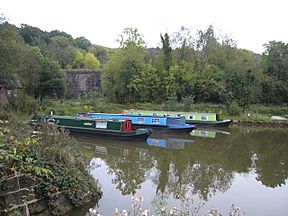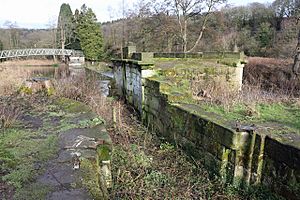Uttoxeter Canal facts for kids
Quick facts for kids Uttoxeter Canal |
|
|---|---|

The basin below lock 1, restored in 2005.
|
|
| Specifications | |
| Length | 13 miles (21 km) |
| Locks | 19 |
| Status | Possible restoration |
| History | |
| Original owner | Trent and Mersey Canal Company |
| Principal engineer | John Rennie |
| Date of act | 1797 |
| Date completed | 13 November 1811 |
| Date closed | 15 January 1849 (replaced by railway) |
| Date restored | July 2005 (1 lock and basin) |
| Geography | |
| Start point | Froghall |
| End point | Uttoxeter |
| Branch of | Caldon Canal |
The Uttoxeter Canal was a 13-mile long waterway in Staffordshire, England. It connected to the Caldon Canal at Froghall and stretched all the way to Uttoxeter. Even though it was approved in 1797, it didn't open until 1811. Most of the canal closed in 1849. This happened so a railway, the Churnet Valley line, could be built where the canal used to be. Today, the railway is gone, and people hope to bring the canal back to life.
Contents
Building the Uttoxeter Canal
The Trent and Mersey Canal Company wanted to build the Uttoxeter Canal. They got permission from Parliament in 1797. This was a smart move to stop another company from building a rival canal. That other canal would have connected different areas and might have taken away business from the Trent and Mersey Company.
Canal Construction and Opening
In 1802, the company got permission to change the canal's path near Alton. Building the canal was delayed because people thought it wouldn't make much money. Ten years after getting permission, work finally started. The famous canal engineer John Rennie led the project. The 13-mile canal opened on September 3, 1811. It is sometimes called a branch of the Caldon Canal. The canal needed 19 locks to lower the boats as it followed the Churnet River valley.
Froghall Basin and Limestone
Froghall Basin was a busy place where limestone was moved. The limestone came from the Caldon Low quarries, a few miles away. It was carried on a special track called a plate tramway. This was one of the first tracks to use iron rails, built in 1758. The tramway was rebuilt several times, and in 1849, it became a cable railway. Three small locomotives worked at Froghall Basin. Their names were Toad, Frog, and Bobs. The quarries stopped working in 1920.
Closing the Canal
There were ideas to build more branches from the canal, but they never happened. The Uttoxeter Canal didn't make much money. The Trent and Mersey Company planned to close it. However, the North Staffordshire Railway company took over the canal company. Most of the canal closed on January 15, 1849. Only the first lock and basin at Froghall stayed open until about 1930. A large part of the canal was filled in. This land was then used for the Churnet Valley railway line. Even though the railway is now gone, it once had the UK's first automatic, train-operated level crossing near Uttoxeter.
Some old bridges from the Uttoxeter Canal still exist today. You can also spot a few old mileposts. Two of these mileposts were moved to the bowling green in Denstone village. In Uttoxeter, you can still find an area called "The Wharf," which shows the canal was once there.
Bringing the Canal Back to Life
The Caldon Canal Society started in 1961. They worked hard to reopen the Caldon Canal to Froghall. This was finished in 1974. Froghall Wharf was the end of the canal for about 25 years.
Restoration at Froghall
Around 2000, people started thinking about restoring the first lock of the Uttoxeter Canal. They also wanted to restore the basin below it. This project was called "Restoration Froghall" in 2003. It also planned for better facilities at the canal's end. The project cost £800,000 and got money from a special fund. By the end of 2003, British Waterways teamed up with the Caldon and Uttoxeter Canals Trust. They planned to finish the project by early 2005. It took a little longer, but the lock and basin officially reopened in July 2005.
Future Restoration Plans
After the Froghall project, the Caldon and Uttoxeter Canals Trust looked at restoring the rest of the canal. This would be from Froghall all the way to Uttoxeter. The situation is tricky because the Churnet Valley Railway also uses part of the old route. There were also plans for a new bypass road. This road would have been built along the canal's path from Denstone to Alton Towers. The Trust fought against this road. They used a government rule that says new roads should not stop canal restoration. The new owners of Alton Towers also agreed that the road was not needed.
South of Denstone, the original canal path is blocked by the JCB factory in Rocester. This factory was built over the spots where two locks, Cottons and Taylors, used to be. In 2009, the local council and the Trust asked engineers to study possible new routes. They found two good routes that would go east of the JCB factory. These routes would end at the Uttoxeter gravel pits, which were almost empty.
Work Near Alton Towers
In the 2010s, the Trust focused on a 1.5-mile section from Alton to Crumpwood Weir. Most of this land belongs to the Alton Towers theme park. Bridge 70 was the only original bridge left on the canal. Its owner was unknown, so the local council bought it. They then sold it to the Trust for just £2. The bridge was restored by September 2016. About 330 yards of the path next to it were also fixed.
The Waterway Recovery Group has visited the canal many times. They have cleared most of the trees in this area. They even removed a huge sycamore tree whose roots were damaging Crumpwood Weir. They also found that Carringtons Lock, just above the weir, was mostly still there, even though it was buried. They also found a wharf built in 1814 by Lord Shrewsbury. This wharf was used to unload building materials for Alton Towers House. Divers have checked Crumpwood Weir. It is in good condition, though one end is filled with mud. John Rennie built this weir so the canal could cross the river at the same level. The weir itself is about 33 yards long and is a grade II listed structure. Water drops 5 feet down a slope at the weir.
Just south of the weir, the old lock keeper's cottage was empty for many years. It was sold in August 2018 and was being fixed up in early 2019. North of the weir, there is an old water pumping station. The Environment Agency plans to build a fish ladder there. This will help trout and salmon swim up the river more easily. The pumping station has water turbines. These turbines used to pump drinking water to local homes. The new fish pass will use the old pipes from the turbines. This will create a resting pool for the fish. People hope to run the turbines sometimes to show how the old machinery worked.
Images for kids



